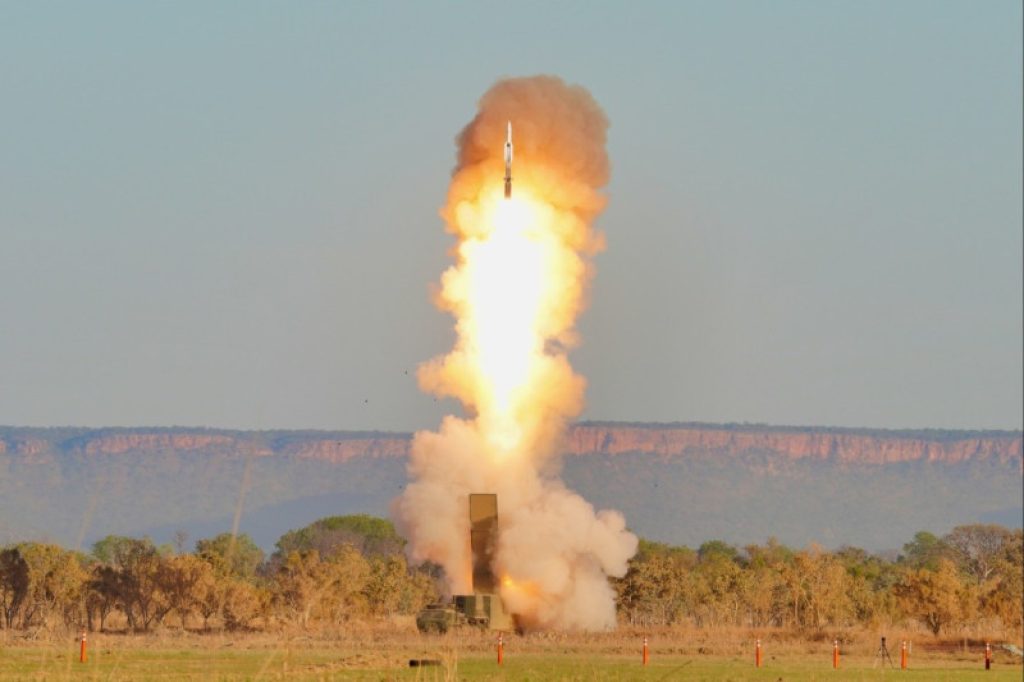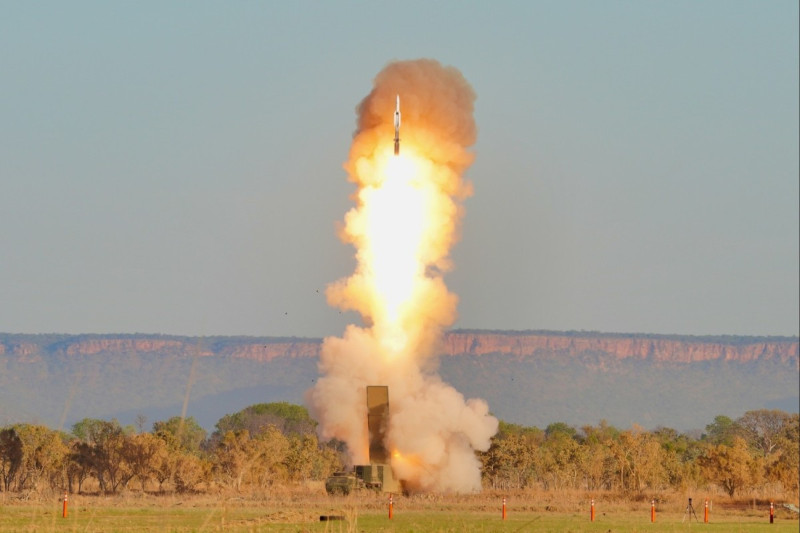 A Typhon launcher from the US Army’s 3rd Multi-Domain Task Force fires an SM-6 missile to strike a maritime target during Exercise Talisman Sabre 25 on July 16, 2025. (US Army photo by Sergeant Perla Alfaro)
A Typhon launcher from the US Army’s 3rd Multi-Domain Task Force fires an SM-6 missile to strike a maritime target during Exercise Talisman Sabre 25 on July 16, 2025. (US Army photo by Sergeant Perla Alfaro)
Berlin is interested in buying the US-made Typhon missile launch system, German Defense Minister Boris Pistorius announced earlier this month after meeting with his American counterpart in Washington, where they also discussed Ukraine aid and planned US missile deployments. Germany hopes the Typhon can fill a glaring gap in European long-range precision-strike capabilities until European-developed systems enter service.
The German request
Following the meeting, Pistorius told journalists that Berlin had submitted a formal Letter of Request to begin the Foreign Military Sales process for the Typhon. He said that US Secretary of Defense Pete Hegseth had welcomed the request, which is “now under review.”
If approved, Berlin will receive a Letter of Offer and Acceptance. “Only then will we in Germany decide whether we will actually proceed with the procurement,” Pistorius said. “When that [letter] will come and what it will look like remains to be seen.”
Background on the Typhon
The US Army developed the Typhon, also known as the Mid-Range Capability or Strategic Mid-Range Fires System, to fill the range gap between its new Precision Strike Missile and Long-Range Hypersonic Weapon, or “Dark Eagle.” Each of the US Army’s five multi-domain task forces will field the system or has already done so.
The Typhon is designed to fire the Navy’s Tomahawk and SM-6 missiles from ground-based launchers. The Tomahawk is a subsonic cruise missile currently manufactured in both land-attack and anti-ship variants, capable of striking targets more than 1,600 kilometers away. The SM-6 is a multi-mission missile primarily used for air and missile defense, but it also offers secondary capabilities against land and sea targets, essentially functioning as a short-range ballistic missile.
A Typhon battery comprises a trailer-based battery operations center and four trailer-based launchers, each towed by HEMTT-family 8×8 tractors, plus reloading and support vehicles. Each launcher can hold up to four missiles fired by a modified version of the Navy’s MK 41 Vertical Launching System.
Developing the Typhon based on existing systems allowed it to be fielded faster. The US Army initiated the program in 2020, following the dissolution of the INF Treaty, which had proscribed such missiles, and has since stood up two Typhon batteries.
The 1st Multi-Domain Task Force deployed the Typhon for the first time in April 2024 for an exercise in the Philippines, where the system has remained. Earlier this month, the 3rd Multi-Domain Task Force conducted the first live-fire Typhon launch on foreign soil during an exercise in Australia, using an SM-6 to sink a mock enemy ship. Based on this experience, the US Army intends to shrink the size of the launcher.
Planned US deployment in Europe
The 2nd Multi-Domain Task Force, headquartered in Germany, is expected to field its Typhon battery in fiscal year 2026 as part of its soon-to-be-activated long-range fires battalion. The other two multi-domain task forces are scheduled to receive their Typhon batteries within the subsequent two years.
In a July 2024 joint statement with Germany, the United States confirmed it would “begin episodic deployments” of 2nd MDTF’s “long-range fires capabilities […] in Germany in 2026, as part of planning for enduring stationing of these capabilities in the future.” This effort will include the Typhon and, later, the Dark Eagle, the statement noted.
Pistorius said he had discussed that commitment with Hegseth. The Pentagon is reviewing the matter and has yet to make a “final decision,” the German defense minister stated, though he said he is confident that Washington will follow through.
Filling a gap
NATO needs more long-range missiles, as Major General John Rafferty, the chief of staff of US European Command and former head of 56th Artillery Command, stressed earlier this month. The Russian military “is bigger today than it was when they started the war in Ukraine,” and Moscow will “continue to invest in long-range rockets and missiles and sophisticated air defenses,” he noted. “So more alliance capability is really, really important.”
Europe, in particular, faces a major capability gap in long-range strikes compared to Russia. At present, NATO relies overwhelmingly on the United States for these capabilities, even as Washington shifts its focus to the Indo-Pacific. Typhon’s “range […] is significantly greater than what we currently have in Europe,” Pistorius noted during his press conference. Other than Turkey, no European ally possesses a conventional ground-launched missile with a range exceeding 300 kilometers.
To fill this gap, Germany, France, Italy, and Poland last year kicked off a joint project called the European Long-range Strike Approach (ELSA), later joined by Sweden, the United Kingdom, and the Netherlands. As part of ELSA, Germany and the United Kingdom are co-leading the development of a “Deep Precision Strike capability” that will have a range of “over 2,000 km.”
However, capabilities developed under ELSA will not arrive for “about seven to ten years, depending on the specific system,” Pistorius explained. He described Typhon as an “interim solution” — a “bridge” between the “temporary” US missile deployments in Germany and the development of indigenous European systems.
